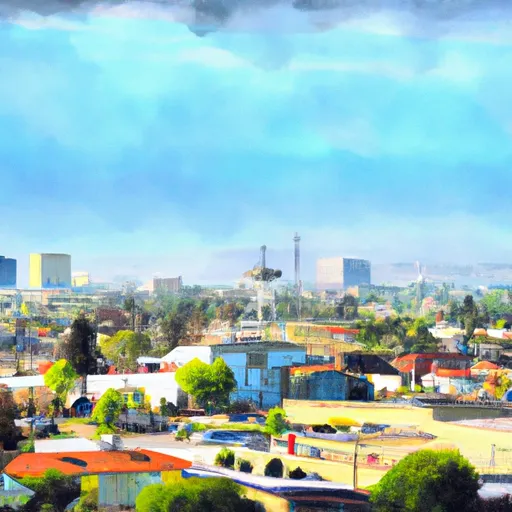-
 Snoflo Premium
Snoflo Premium
Get unlimited access to all our content
With no Ad interruptions! - Start Your Free Trial Login with existing account
Temple-City
Eden Index
Climate
9.4
•
Recreation
7.6
•
Community
3.0
•
Safeguard
7.1/10

Temple City is a charming city located in Los Angeles County, California. Situated in the San Gabriel Valley, the climate of Temple City is generally pleasant, characterized by warm and sunny summers and mild winters. Summers tend to be dry with temperatures averaging in the mid-80s Fahrenheit, while winters experience cooler temperatures in the mid-60s.
The hydrology constituents of Temple City primarily revolve around the San Gabriel River which flows nearby. This river is an important source of water for the region and offers opportunities for recreational activities such as fishing, boating, and picnicking along its banks.
In terms of outdoor recreation, Temple City boasts several beautiful parks and green spaces. Live Oak Park features playgrounds, sports fields, and picnic areas, providing an ideal spot for family gatherings. Temple City Park offers amenities like a swimming pool, skate park, and tennis courts. For nature enthusiasts, the nearby San Gabriel Mountains provide fantastic opportunities for hiking, camping, and exploring breathtaking scenery.
Overall, Temple City offers a delightful climate, access to the San Gabriel River, and a range of outdoor recreation activities, making it an appealing destination for residents and visitors alike.
What is the Eden Index?
The Snoflo Eden Index serves as a comprehensive rating system for regions, evaluating their desirability through a holistic assessment of climate health, outdoor recreation opportunities, and natural disaster risk, acknowledging the profound impact of these factors on livability and well-being.
Climate Health Indicator (CHI): 9.4
Temple-City receives approximately
447mm of rain per year,
with humidity levels near 58%
and air temperatures averaging around
19°C.
Temple-City has a plant hardyness factor of
10, meaning
plants and agriculture in this region tend to thrive here all year round.
By considering the ideal temperature range, reliable water supplies, clean air, and stable seasonal rain or snowpacks, the Climate Health Indicator (CHI) underscores the significance of a healthy climate as the foundation for quality living.
A healthy climate is paramount for ensuring a high quality of life and livability in a region, fostering both physical well-being and environmental harmony. This can be characterized by ideal temperatures, reliable access to water supplies, clean air, and consistent seasonal rain or snowpacks.
Weather Forecast
Streamflow Conditions
Ventura-San Gabriel Coastal
Area Rivers
Ventura-San Gabriel Coastal
Snowpack Depths
Ventura-San Gabriel Coastal
Reservoir Storage Capacity
Ventura-San Gabriel Coastal
Groundwater Levels
Recreational Opportunity Index (ROI): 7.6
The Recreational Opportunity Index (ROI) recognizes the value of outdoor recreational options, such as parks, hiking trails, camping sites, and fishing spots, while acknowledging that climate plays a pivotal role in ensuring the comfort and consistency of these experiences.
Access to outdoor recreational opportunities, encompassing activities such as parks, hiking, camping, and fishing, is crucial for overall well-being, and the climate plays a pivotal role in enabling and enhancing these experiences, ensuring that individuals can engage in nature-based activities comfortably and consistently.
Camping Areas
| Campground | Campsites | Reservations | Toilets | Showers | Elevation |
|---|---|---|---|---|---|
| Oakwilde | 7 | 1,831 ft | |||
| Bolsa Chica State Beach | 57 | 12 ft | |||
| Coldbrook | 20 | 3,285 ft | |||
| Sunset Vista RV Park | None | 19 ft | |||
| Glenn Camp | 8 | 2,095 ft | |||
| Millard | 5 | 1,980 ft | |||
| Gould Mesa | 7 | 1,418 ft | |||
| Seabreeze at Seal Beach Military | None | 15 ft | |||
| Los Alamitos Army Military | None | 25 ft | |||
| Devore | 6 | 2,914 ft |
Catastrophe Safeguard Index (CSI):
The Catastrophe Safeguard Index (CSI) recognizes that natural disaster risk, encompassing floods, fires, hurricanes, and tornadoes, can drastically affect safety and the overall appeal of an area.
The level of natural disaster risk in a region significantly affects safety and the overall livability, with climate change amplifying these risks by potentially increasing the frequency and intensity of events like floods, fires, hurricanes, and tornadoes, thereby posing substantial challenges to community resilience and well-being.
Community Resilience Indicator (CRI): 3.0
The Community Resilience Indicator (CRI) recognizes that education, healthcare, and socioeconomics are crucial to the well-being of a region. The CRI acknowledges the profound impact of these elements on residents' overall quality of life. By evaluating educational resources, healthcare accessibility, and economic inclusivity, the index captures the essential aspects that contribute to a thriving community, fostering resident satisfaction, equity, and social cohesion.

